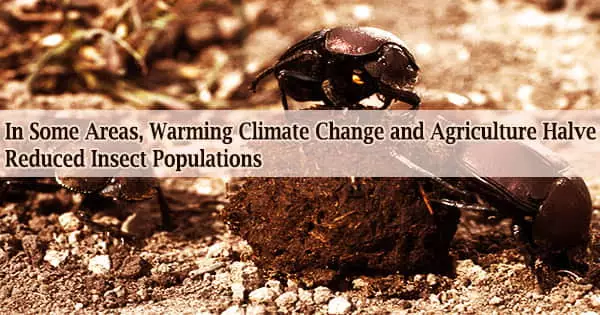According to a new study by UCL researchers, climate change and intensive agricultural land usage have already resulted in a 49 percent decline in the number of insects in the most damaged places of the world.
Among the many potential consequences of global warming, the threats to global agriculture stand out as one of the most serious. Yet, in recent years, there has been a trend in the climate economics literature to downplay this risk, even to claim that a few degrees Celsius of warming would be beneficial to global agriculture.
However, such investigations usually have a very short time horizon (generally out to about 2050). They also place a greater emphasis on overall temperature change (which includes seas) than on changes that will occur over land (which warms more easily and fast than water) and specifically on agricultural land.
The study, published in Nature, is the first to show that a combination of rising temperatures and land use changes is causing widespread insect losses around the world.
Lead author Dr. Charlie Outhwaite (UCL Centre for Biodiversity & Environment Research, UCL Biosciences) said:
“Many insects appear to be very vulnerable to human pressures, which is concerning as climate change worsens and agricultural areas continue to expand. Our findings highlight the urgency of actions to preserve natural habitats, slow the expansion of high-intensity agriculture, and cut emissions to mitigate climate change.”
“Losing insect populations could be harmful not only to the natural environment, where insects often play key roles in local ecosystems, but it could also harm human health and food security, particularly with losses of pollinators.”
“Our findings may only represent the tip of the iceberg as there is limited evidence in some areas, particularly in the tropics which we found have quite high reductions in insect biodiversity in the most impacted areas.”
It is commonly acknowledged that the consequences of global warming on agriculture will harm developing countries more than industrialized countries.
The environmental harms of high-intensity agriculture present a tricky challenge as we try to keep up with the food demands of a growing population. We have previously found that insect pollinators are particularly vulnerable to agricultural expansion, as they appear to be more than 70% less abundant in high-intensity croplands compared to wild sites. Careful management of agricultural areas, such as preserving natural habitats near farmland, may help to ensure that vital insects can still thrive.
Dr. Tim Newbold
Most underdeveloped countries are less adaptable than their affluent counterparts. The majority of them are in hotter places of the world, where temperatures are already approaching or above thresholds where future warming will reduce rather than boost agricultural output.
Agriculture also accounts for a bigger proportion of developing countries than industrial economies. However, determining how much individual countries are expected to be affected has been tricky.
The researchers looked at a vast dataset of insect abundance and species richness from throughout the world, which included roughly 20,000 insect species and three-quarters of a million recordings.
The researchers evaluated insect biodiversity in different places based on how intense agriculture is in the area and how much previous climate warming has occurred.
They discovered that in places with high-intensity agriculture and significant climate warming, the number of insects was 49 percent lower and the number of distinct species was 29 percent lower than in most natural settings with no observed temperature warming. Insect biodiversity has declined the most in tropical areas as a result of land use and climate change.
The researchers discovered that having nearby natural habitat buffered losses in areas with low-intensity agriculture and significant climate warming: where natural habitat covered 75 percent of the land, insect abundance decreased by only 7%, compared to a 63 percent reduction in comparable areas with only 25 percent natural habitat cover. On hot days, many insects rely on plants for shade, thus the loss of natural habitats could make them more vulnerable to climate change.
Many locations with lengthy histories of human impacts would have already witnessed biodiversity losses before the start of the study period, and the study did not account for the effects of other drivers such as pollution, according to the researchers.
Senior author Dr. Tim Newbold (UCL Centre for Biodiversity & Environment Research) said:
“The environmental harms of high-intensity agriculture present a tricky challenge as we try to keep up with the food demands of a growing population. We have previously found that insect pollinators are particularly vulnerable to agricultural expansion, as they appear to be more than 70% less abundant in high-intensity croplands compared to wild sites. Careful management of agricultural areas, such as preserving natural habitats near farmland, may help to ensure that vital insects can still thrive.”
Joint first author Peter McCann, who conducted the research while completing an MSc at the UCL Centre for Biodiversity & Environment Research, said:
“We need to acknowledge how important insects are for the environment as a whole, and for human health and wellbeing, in order to address the threats we pose to them before many species are lost forever.”
Scientists at the University College London’s Centre for Biodiversity and Environment Research are at the forefront of research into human impacts on the planet, such as developing the science that underpins the IUCN’s Red List, which quantifies extinction risk, and discovering that changes in land use may be increasing the risk of disease outbreaks like Covid-19, which jump from animals to humans.
The center’s new interdisciplinary People and Nature Lab is researching innovative techniques to address these important global concerns, such as citizen science programs and artificial intelligence, in order to build a more sustainable interaction between people and nature.
The Natural Environment Research Council and the Royal Society funded the study.
















